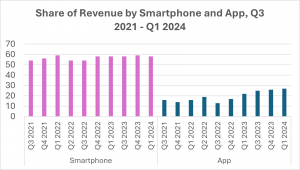By Ellie-Rose Davies, Content Executive at IMRG
IMRG’s data shows that smartphones consistently drive over half of online retail revenue, highlighting their growing role in eCommerce. As mobile apps become increasingly popular, thanks to better features, user experiences, and greater incentivisation, many retailers are refining their strategies.
From using AI and AR to personalise shopping experiences to improving checkout and delivery processes, there are many ways to enhance mobile commerce. In this blog, we have explored current trends and expert tips to help retailers fine-tune their mobile strategies and boost sales in 2024.
Mobile Commerce trends: IMRG benchmarking data
According to IMRG’s Online Retail Index data, the average revenue share for smartphone has remained stable from Q3 2021 to Q1 2024, always remaining over 50% (see chart). In recent quarters, it has remained at a higher base, signalling the growing importance of mobile commerce.

The incremental growth in app revenue share across this period highlights the effectiveness of mobile apps in driving sales. Retailers are likely enhancing app functionalities, user experience, and marketing efforts to attract more users to their apps. This growth can also be attributed to changes in consumer behaviour, with more customers opting for the convenience and personalised experiences that apps offer.
Retailers can analyse customer behaviour data to refine their mobile commerce strategies, catering to the preferences of both smartphone and app users.
Start of funnel activity: Personalisation, design, and incentivising app usage
Retailers can optimise mobile commerce from the very beginning of the purchasing journey, when customers are browsing for items. Early on, retailers can implement personalisation, refine layout/design, and incentivise app usage to prompt higher engagement and better conversion.
According to Kathy Klingler, Chief Marketing Officer at Brightcove, there has been ‘a notable rise in the use of AI and machine learning (ML) to provide personalised shopping experiences’ this year. She notes that ‘AI-driven recommendations, chatbots, and virtual assistants are becoming essential tools for enhancing customer engagement and satisfaction.’ Augmented reality (AR) features also ‘allows customers to visualise products in their own space, significantly influencing purchasing decisions.’
Kathy also explores how ‘short-form video content and live streaming have emerged as powerful tools for product demonstrations and real-time customer interaction.’ The popularity of short-form video content optimised for mobile devices has been propelled by social media platforms.
Lauren Dumont, UX/UI Designer at Space 48, reflects on how ‘the likes of Instagram and TikTok has influenced how people expect mobile sites to work and how they behave with them.’ More retailers are using features like ‘user generated content (UGC), social proofing, “shop the look” content blocks, short videos built for mobile screens, etc.’
Lauren continues, ‘Also there is an increase of users using Instagram and TikTok search like they would Google, so it’s a whole new platform that can be used to boost customer engagement. It’s fascinating because social media has been around for so long, but I don’t see many businesses using it to their advantage.’
Adding to this, Dan Davies, Senior Design Lead at Space 48, discusses how visuals are shaping the future of mobile commerce, especially in enhancing UX in app design. He says, ‘Retailers can optimise their apps by focusing on a user-friendly interface, ensuring intuitive design, easy navigation, and fast load times.’
Dan exclaims, ‘Personalisation plays a crucial role, too. It’s crucial to provide tailored recommendations to users, including visual search capabilities, which is key on mobile. […] Push notifications keep users engaged, too. They’re especially helpful for order statuses, new deals, and promotions.’
Luke McDermott, Head of Optimisation at ASK BOSCO, agrees that design plays a crucial role in boosting online performance. He notes ‘major improvements made to the products pages and checkout’ across the sector.
He shares that ‘structuring product pages to have smaller imagery (15% reduction) to allow headlines and putting the price above the fold have improved CvRs by 8-12% across our client base. We’ve also seen great results from restructuring carts and sticky call to action buttons through product page and into the checkout – reducing cart abandonments by 32%.’
In addition to making apps more attractive through sleek design, added visual elements, and personalisation, Bill Schneider, VP of Product Marketing at SheerID, reveals the value of incentivising app usage through offering ‘premium experiences.’
Bill says some of the best ways to deliver premium experiences are when ‘mobile apps are combined with other elements such as gated offers for a community like college students or teachers. Some retailers are using gated offers as a method to encourage sign up in their loyalty app.’
In turn, ‘students benefit from the latest tech in the app — like virtual try on and social sharing — and are encouraged to share their gated offer with other students. They engage and you earn lifelong customers,’ shares Bill.
Clementyne Lavender, Head of Strategic Partnerships & Innovation at Awin says, ‘Apps need fast load times, flexible payment options, and excellent user experiences to encourage usage. For example, retailers injecting creativity with AR technology, allowing customers to virtually try products, are seeing success. To drive conversions and maintain loyalty, consider location-based services, relevant push notifications and strategic incentives such as limited time offers, redeemable only in-app.’
End of funnel activity: Checkout, payments, and delivery
There are also ways to improve the mobile experience at the end of the purchasing funnel, at the time when customers are going to the checkout, making a payment, or are waiting for their delivery.
Sean Sherwin Smith, Product Director Post-Purchase at nShift, reveals that their recently conducted research found that ‘In 2023, the percentage of online shopping baskets being abandoned rose to 70% globally for the first time in a decade. However, this figure was even higher for mobile shopping at 85%.’

To help convert these more hesitant mobile shoppers, the research conducted by nShift found that ‘the right delivery options and order tracking matter more to the customer experience than loyalty schemes and other perks.’ Retailers who offer this should foreground it at the checkout, and retailers that do not can consider including this as part of their strategy.
Sean says, ‘far too many brands see deliveries as simply “box-shifting.” But treating shipping as a purely logistical feat means retailers miss opportunities to turn deliveries into a competitive advantage […] especially when it comes to mobile commerce.’
As well as clearly outlining delivery options and offering excellent customer experiences such as online tracking, retailers can refine their pricing strategies to drive mobile commerce success in 2024.
Burc Tanir, CEO at Prisync says, ‘Retailers can stand out by integrating dynamic pricing strategies that respond to market changes instantly. Enhance UX with fast load times, easy navigation, and secure transactions. It is also important to offer ‘frictionless payments, and a seamless checkout process.’
Monica Eaton, Founder and CEO at Chargebacks911, attributes the rise of mobile commerce to the convenience of smartphones and increased mobile payment options. ‘Mobile commerce is rising, due in part to the increase in mobile payment options,’ she says, noting that mobile wallets like Apple Pay and Google Pay are more popular as people always have their phones with them.
Despite the growth, security issues persist. ‘Nearly three-quarters (72%) of consumers consider a chargeback a valid alternative to seeking a refund directly from a brand,’ Monica explains, highlighting the ease of digital chargebacks, which increases the risk of ‘friendly fraud.’
Monica advises that brands should invest in post-sale strategies as much as they do in optimising the mobile experience. ‘They can ensure that billing descriptors are easily recognisable, consumers have all necessary delivery information and updates, keep a well-organised paper trail of every transaction, communicate clearly and regularly with customers, grant refunds and cancellations as soon as requested and always be on the lookout for suspicious behaviour,’ Monica says.
By focusing on these strategies and staying responsive to evolving consumer behaviours, retailers can effectively enhance their mobile commerce approach and better meet their customers’ needs.
Want to read more? Here are some other IMRG blogs that cover a range of ecommerce topics:
Top 11 Commerce Trends For Retailers In 2024 – IMRG
Brexit’s Impact On Retail And The Marketplace Opportunity To Thrive – IMRG
Top Cross-Border eCommerce Trends In 2024 – IMRG
Google Shopping Optimisation – Pricing, Titles, and More – IMRG
The New & Innovative Ways Retailers Can Use AI In 2024 – IMRG
Published 29/07/2024



